16+ Sample Quality Assurance Agreements
-
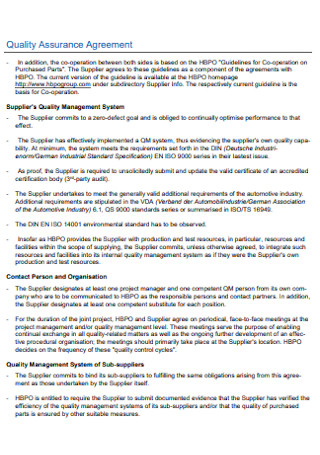
Sample Quality Assurance Agreement
download now -

Quality Assurance Agreement for Suppliers
download now -

Supplier Quality Assurance Agreement
download now -
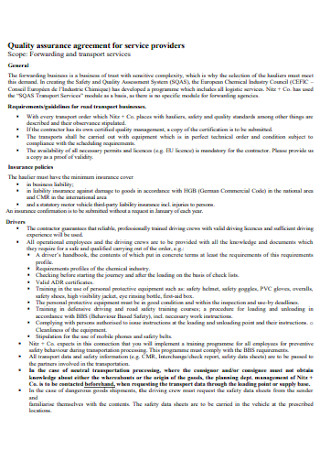
Quality Assurance Agreement for Service providers
download now -
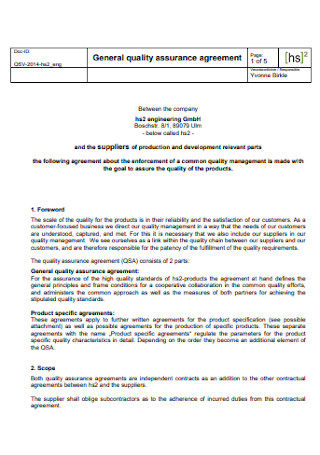
General Quality Assurance Agreement
download now -
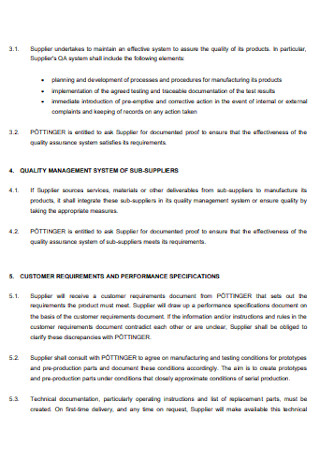
Parts Quality Assurance Agreement
download now -
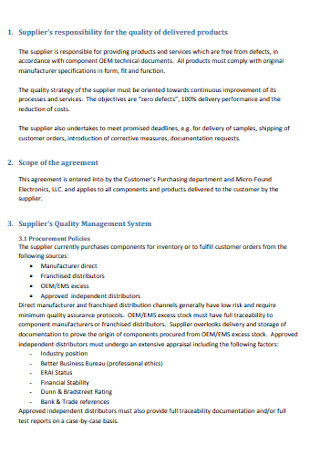
Electronics Quality Assurance Agreement
download now -
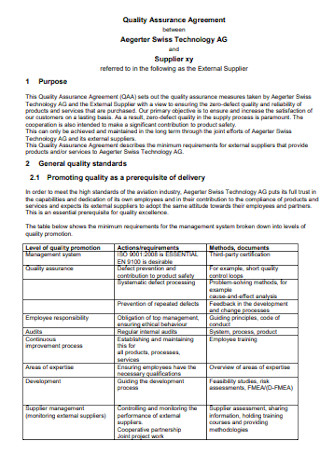
Quality Assurance Agreement Format
download now -
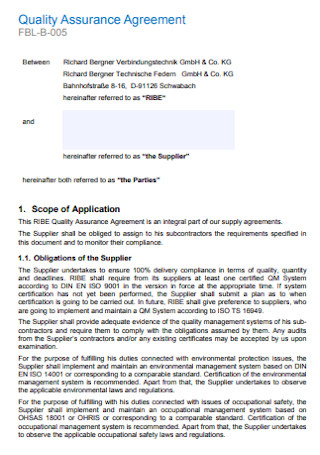
Basic Quality Assurance Agreement
download now -
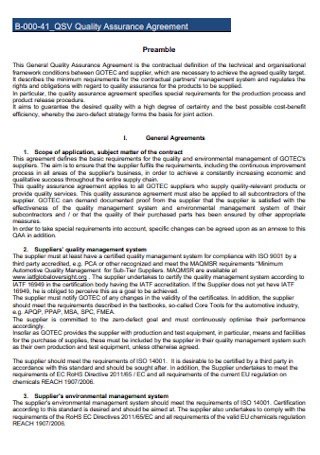
Simple Quality Assurance Agreement
download now -
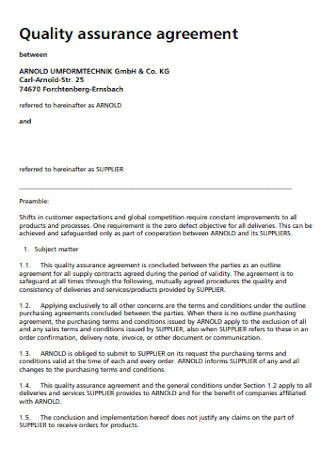
Formal Quality Assurance Agreement
download now -
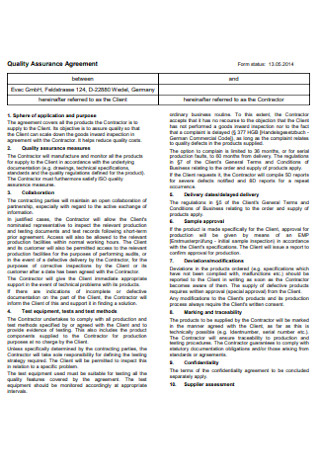
Standard Quality Assurance Agreement
download now -

Printable Quality Assurance Agreement
download now -
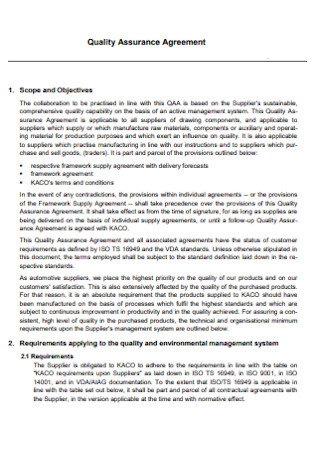
Professional Quality Assurance Agreement
download now -
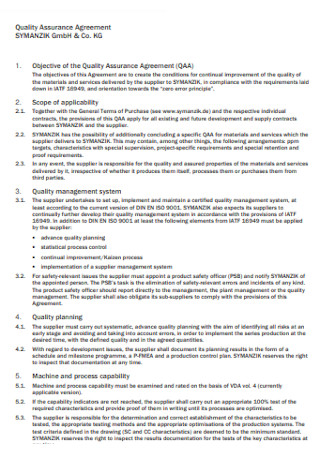
Quality Management Assurance Agreement
download now -
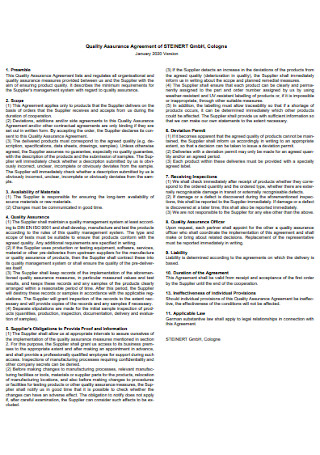
Product Quality Assurance Agreement
download now -
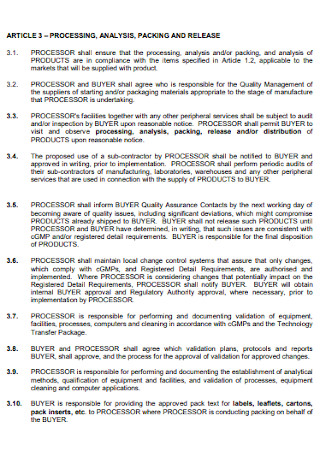
Company Quality Assurance Agreement
download now
FREE Quality Assurance Agreement s to Download
16+ Sample Quality Assurance Agreements
What is a quality assurance agreement?
What should a quality assurance agreement contain?
How to Implement a Quality Assurance Test
Why do I need to have a quality assurance agreement?
Is a quality agreement a legal document?
What are good application tools used for quality assurance?
What is a quality assurance agreement?
A quality assurance agreement is a document that holds the mutual agreement between the parties involved in writing. These parties are entities that take part during quality management, such as the human resources or personnel, the suppliers, the manufacturing department and the like. In this agreement, the responsibilities of each party are outlined and explicitly stated in order for the constituents to have a clearer scope and delimitation of what they are supposed to do for the project at hand. The quality assurance agreement therefore is a legally binding contract that can hold signatories accountable for sudden withdrawal, failure to do their intended tasks, and non-compliance to the promised consensus written in the file.
What should a quality assurance agreement contain?
Given the brief overview of what a quality assurance agreement is, its nature is already laid out for the readers to get a grip of. However, it is important to dissect the important parts of the said document because of the amount of legal gravity it holds, as well as the transactional relationship of the parties. Learning and getting familiarized with the content of a quality assurance agreement enables you to anticipate your later responsibilities, and the important things to consider once you plan to sign such a document.
How to Implement a Quality Assurance Test
The quality assurance agreement is one of the most important fundamental documents needed before running an assurance test. It is at par with the product test plans which are outlines of the process of the execution in and of itself. The former elaborately deals with the actors involved in the quality assurance test, while the latter deals with the dynamics of it. Still, the most important, and perhaps the biggest thing about the topic at hand, is of course the test itself, which is why the steps to be taken in order to conduct one are things you ought to be familiarized with.
Step 1: Quality Management Software
Software are very important and helpful tools during the execution of a whole project. It helps in keeping you organized, and your teams in sync as your software, for instance, takes its launch. Readying a good and reliable quality management software is the first step you can take in implementing your quality assurance test. Quality management software are also just generally good in risk management.
Step 2: Observation
When the test commences, it is important for you and the different teams you may have to observe the nature of the product once it is being run. Here, you are able to spot glitches or flaws which you can fix in post. During this time, you may take notes of your observations in order for you to disseminate the information to the team responsible in processing that compartment of the project. List down the strengths you see in the product as well such as the smoothness of the production process, security, and stability in order for you to keep in mind the things that are successfully built for the project.
Step 3: Feedback
Perhaps you may have acting customers to use the product first in order for external parties to gauge the promised purpose of your asset, or you may have your set of professional teams give comments on the run of the product. During feedback, you are able to get points of information and points of improvement from third parties, since the success of your product is mostly based on the consumers’ approval. Post surveys could also be a good idea in order for you to have a more tangible and quantifiable result.
Step 4: Revisions
When talking about quality assurance, it is inevitable not to tie it back to constantly changing the product to meet expectations. The whole point of quality assurance is basically to see if something is already good enough to be put out in the market. Revisions may happen in macro scale or a micro scale, i.e. it could range from changing a few codes in your software to solve a glitch, to you having to invest in more staffing or production processes.
Step 5: Assessing Results
Once your product is finally out, you may begin to assess the outcomes of it. Goal-setting is perhaps one of the initial concepts written in your test plan, and in this step, you may compare real-world data to your primary expectations. However, it is very possible that your expectations will later turn out to be things you find are actually not arbitrary to the nature of your product, as new information and insights come in with the product being part of the lived experiences of people. The success of the product at the end of the day, is still measured and decided by you.
Why do I need to have a quality assurance agreement?
It is important to have it because it legally binds the parties into the consensus they have made regarding responsibilities, tasks and supplies, and it ensures that all of them get to fulfill their promised transaction. With the quality assurance agreement, it is also far easier to hold them accountable should things go in unexpected turns.
Is a quality agreement a legal document?
Yes. It establishes the contractual relationship between the parties present in quality assurance, and signing it is surely involving the law in their transaction.
What are good application tools used for quality assurance?
Software surely make our tasks much easier, and the results much more reliable. A few good application tools for quality assurance are Zephyr Scale, TestCollab, Kualitee, and PractiTest.
Quality assurance makes your product a lot more marketable and enticing, hence the investments you make in the background are very well justified. Part of the quality management of a product are the connections you establish in creating a team to serve as the pillars of the project, which is why making sure to have a good and elaborate quality assurance agreement is in your best interest. Once you have a quality assurance agreement, all parties are bound to commit to their responsibilities and promises, but other than that, you also have a safeguard for when things might go haywire since it has strong legal gravity. Conclusively, the quality assurance agreement is a strategic safety net for you to have to secure a bright future for the investments that you made.
